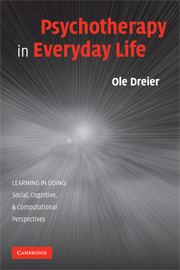Book contents
- Frontmatter
- Contents
- Series Foreword
- Preface
- Introduction
- 1 Re-Searching Psychotherapy as a Social Practice
- 2 Theorizing Persons in Structures of Social Practice
- 3 A Study – Its Design and Conduct
- 4 Clients' Ordinary Lives Plus Sessions
- 5 Therapy in Clients' Social Practice across Places
- 6 Changes in Clients' Practice across Places
- 7 Changing Problems across Places
- 8 The Conduct of Everyday Life and the Life Trajectory
- 9 The Children's Changing Conducts of Everyday Life and Life Trajectories
- 10 The Parents' Changing Conducts of Everyday Life and Life Trajectories
- 11 The Changing Conduct of Everyday Family Life and Family Trajectory
- 12 Research in Social Practice
- References
- Author Index
- Subject Index
- Learning in Doing: Social, Cognitive, and Computational Perspectives
2 - Theorizing Persons in Structures of Social Practice
Published online by Cambridge University Press: 15 December 2009
- Frontmatter
- Contents
- Series Foreword
- Preface
- Introduction
- 1 Re-Searching Psychotherapy as a Social Practice
- 2 Theorizing Persons in Structures of Social Practice
- 3 A Study – Its Design and Conduct
- 4 Clients' Ordinary Lives Plus Sessions
- 5 Therapy in Clients' Social Practice across Places
- 6 Changes in Clients' Practice across Places
- 7 Changing Problems across Places
- 8 The Conduct of Everyday Life and the Life Trajectory
- 9 The Children's Changing Conducts of Everyday Life and Life Trajectories
- 10 The Parents' Changing Conducts of Everyday Life and Life Trajectories
- 11 The Changing Conduct of Everyday Family Life and Family Trajectory
- 12 Research in Social Practice
- References
- Author Index
- Subject Index
- Learning in Doing: Social, Cognitive, and Computational Perspectives
Summary
I shall now introduce a theoretical framework in which to analyze my study. This framework must allow us to grasp how specific structural arrangements of social practice let practices in a social context work beyond their boundaries and affect how they do so. It must also enable us to understand persons moving across diverse social contexts in their ongoing social practice. For that we need a theory of persons in social practice – a term preferred over the clumsier “societal practice,” which refers to a practice with intertwined material and social qualities. The framework is of much more general relevance than my study. Its most important backgrounds are in the theory of individual subjectivity from the standpoint and perspective of the subject in critical psychology (e.g., Holzkamp 1983; Tolman 1994; Tolman and Maiers 1991) – which is a variant of activity theory developed by Leont'ev (1978; 1979) and others in the Russian sociohistorical school – and Lave's situated approach to social practice (e.g., Lave and Wenger 1991). As introduced, the framework holds several concepts that were developed in the analysis of the study I present in this book. The challenges I faced in my earlier attempts to analyze these, and other, materials triggered its development. As a result of these experiences, I modified and added some basic theoretical concepts as well as some more specific and local concepts.
- Type
- Chapter
- Information
- Psychotherapy in Everyday Life , pp. 21 - 46Publisher: Cambridge University PressPrint publication year: 2007
- 1
- Cited by



